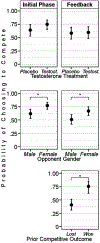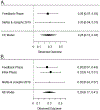The causal effect of testosterone on men's competitive behavior is moderated by basal cortisol and cues to an opponent's status: Evidence for a context-dependent dual-hormone hypothesis
- PMID: 35201818
- PMCID: PMC9901191
- DOI: 10.1037/pspa0000305
The causal effect of testosterone on men's competitive behavior is moderated by basal cortisol and cues to an opponent's status: Evidence for a context-dependent dual-hormone hypothesis
Abstract
Testosterone has been theorized to direct status-seeking behaviors, including competitive behavior. However, most human studies to date have adopted correlational designs, and findings across studies are inconsistent. This experiment (n = 115) pharmacologically manipulated men's testosterone levels prior to a mixed-gender math competition and examined basal cortisol (a hormone implicated in stress and social avoidance) and context cues related to an opponent's perceived status (an opponent's gender or a win/loss in a prior competition) as factors that may moderate testosterone's impact on competitive behavior. We test and find support for the hypothesis that testosterone given to low-cortisol men evokes status-seeking behavior, whereas testosterone given to high-cortisol men evokes status-loss avoidance. In the initial rounds of competition, testosterone's influence on competitive decisions depended on basal cortisol and opponent gender. After providing opponent-specific win-lose feedback, testosterone's influence on decisions to reenter competitions depended on basal cortisol and this objective cue to status, not gender. Compared to placebo, men given exogenous testosterone who were low in basal cortisol showed an increased tendency to compete against male and high-status opponents relative to female and low-status opponents (status-seeking). Men given exogenous testosterone who were high in basal cortisol showed the opposite pattern-an increased tendency to compete against female and low-status opponents relative to male and high-status opponents (status-loss avoidance). These results provide support for a context-dependent dual-hormone hypothesis: Testosterone flexibly directs men's competitive behavior contingent on basal cortisol levels and cues that signal an opponent's status. (PsycInfo Database Record (c) 2022 APA, all rights reserved).
Figures





Similar articles
-
Beyond the challenge hypothesis: The emergence of the dual-hormone hypothesis and recommendations for future research.Horm Behav. 2020 Jul;123:104657. doi: 10.1016/j.yhbeh.2019.104657. Epub 2020 Jan 2. Horm Behav. 2020. PMID: 31863735 Free PMC article. Review.
-
Basal testosterone's relationship with dictator game decision-making depends on cortisol reactivity to acute stress: A dual-hormone perspective on dominant behavior during resource allocation.Psychoneuroendocrinology. 2019 Mar;101:150-159. doi: 10.1016/j.psyneuen.2018.11.012. Epub 2018 Nov 10. Psychoneuroendocrinology. 2019. PMID: 30463044 Free PMC article.
-
Exogenous testosterone in women enhances and inhibits competitive decision-making depending on victory-defeat experience and trait dominance.Psychoneuroendocrinology. 2015 Oct;60:224-36. doi: 10.1016/j.psyneuen.2015.07.004. Epub 2015 Jul 13. Psychoneuroendocrinology. 2015. PMID: 26209809
-
Hormonal underpinnings of status conflict: Testosterone and cortisol are related to decisions and satisfaction in the hawk-dove game.Horm Behav. 2017 Jun;92:141-154. doi: 10.1016/j.yhbeh.2017.03.009. Epub 2017 Apr 22. Horm Behav. 2017. PMID: 28365397
-
Testosterone, cortisol, and human competition.Horm Behav. 2016 Jun;82:21-37. doi: 10.1016/j.yhbeh.2016.04.004. Epub 2016 Apr 19. Horm Behav. 2016. PMID: 27103058 Review.
Cited by
-
Effects of testosterone enanthate on aggression, risk-taking, competition, mood, and other cognitive domains during 28 days of severe energy deprivation.Psychopharmacology (Berl). 2024 Mar;241(3):461-478. doi: 10.1007/s00213-023-06502-8. Epub 2023 Dec 1. Psychopharmacology (Berl). 2024. PMID: 38038817 Free PMC article. Clinical Trial.
-
Beyond the challenge hypothesis: The emergence of the dual-hormone hypothesis and recommendations for future research.Horm Behav. 2020 Jul;123:104657. doi: 10.1016/j.yhbeh.2019.104657. Epub 2020 Jan 2. Horm Behav. 2020. PMID: 31863735 Free PMC article. Review.
-
Stress, hypothalamic-pituitary-adrenal axis, hypothalamic-pituitary-gonadal axis, and aggression.Metab Brain Dis. 2024 Dec;39(8):1613-1636. doi: 10.1007/s11011-024-01393-w. Epub 2024 Jul 31. Metab Brain Dis. 2024. PMID: 39083184 Free PMC article. Review.
-
Influence of horse demographics, country of training and race distance on the rating of Thoroughbreds.Arch Anim Breed. 2023 Oct 25;66(4):299-313. doi: 10.5194/aab-66-299-2023. eCollection 2023. Arch Anim Breed. 2023. PMID: 38039343 Free PMC article.
-
Two Routes to Status, One Route to Health: Trait Dominance and Prestige Differentially Associate with Self-reported Stress and Health in Two US University Populations.Adapt Human Behav Physiol. 2022;8(4):461-488. doi: 10.1007/s40750-022-00199-3. Epub 2022 Aug 23. Adapt Human Behav Physiol. 2022. PMID: 36034092 Free PMC article.
References
-
- Bates D, Mächler M, Bolker BM, & Walker SC (2015). Fitting linear mixed-effects models using lme4. Journal of Statistical Software. 10.18637/jss.v067.i01 - DOI
-
- Benjamini Y, & Hochberg Y (1995). Controlling the False Discovery Rate: A Practical and Powerful Approach to Multiple Testing. Journal of the Royal Statistical Society: Series B (Methodological), 57(1), 289–300. 10.1111/j.2517-6161.1995.tb02031.x - DOI
-
- Berdahl JL (2007). Harassment Based on Sex: Protecting Social Status in the Context of Gender Hierarchy. Academy of Management Review, 32(2), 641–658. 10.5465/amr.2007.24351879 - DOI
MeSH terms
Substances
Grants and funding
LinkOut - more resources
Full Text Sources
Miscellaneous

